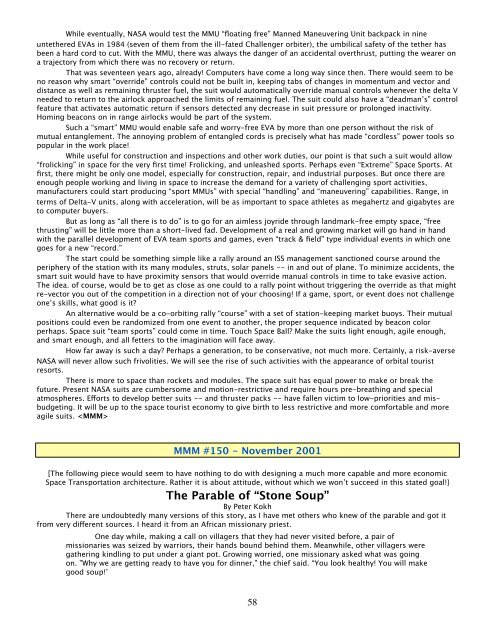Space Transportation - mmmt_transportation.pdf - Moon Society
Space Transportation - mmmt_transportation.pdf - Moon Society
Space Transportation - mmmt_transportation.pdf - Moon Society
You also want an ePaper? Increase the reach of your titles
YUMPU automatically turns print PDFs into web optimized ePapers that Google loves.
While eventually, NASA would test the MMU “floating free” Manned Maneuvering Unit backpack in nine<br />
untethered EVAs in 1984 (seven of them from the ill-fated Challenger orbiter), the umbilical safety of the tether has<br />
been a hard cord to cut. With the MMU, there was always the danger of an accidental overthrust, putting the wearer on<br />
a trajectory from which there was no recovery or return.<br />
That was seventeen years ago, already! Computers have come a long way since then. There would seem to be<br />
no reason why smart “override” controls could not be built in, keeping tabs of changes in momentum and vector and<br />
distance as well as remaining thruster fuel, the suit would automatically override manual controls whenever the delta V<br />
needed to return to the airlock approached the limits of remaining fuel. The suit could also have a “deadman’s” control<br />
feature that activates automatic return if sensors detected any decrease in suit pressure or prolonged inactivity.<br />
Homing beacons on in range airlocks would be part of the system.<br />
Such a “smart” MMU would enable safe and worry-free EVA by more than one person without the risk of<br />
mutual entanglement. The annoying problem of entangled cords is precisely what has made “cordless” power tools so<br />
popular in the work place!<br />
While useful for construction and inspections and other work duties, our point is that such a suit would allow<br />
“frolicking” in space for the very first time! Frolicking, and unleashed sports. Perhaps even “Extreme” <strong>Space</strong> Sports. At<br />
first, there might be only one model, especially for construction, repair, and industrial purposes. But once there are<br />
enough people working and living in space to increase the demand for a variety of challenging sport activities,<br />
manufacturers could start producing “sport MMUs” with special “handling” and “maneuvering” capabilities. Range, in<br />
terms of Delta-V units, along with acceleration, will be as important to space athletes as megahertz and gigabytes are<br />
to computer buyers.<br />
But as long as “all there is to do” is to go for an aimless joyride through landmark-free empty space, “free<br />
thrusting” will be little more than a short-lived fad. Development of a real and growing market will go hand in hand<br />
with the parallel development of EVA team sports and games, even “track & field” type individual events in which one<br />
goes for a new “record.”<br />
The start could be something simple like a rally around an ISS management sanctioned course around the<br />
periphery of the station with its many modules, struts, solar panels -- in and out of plane. To minimize accidents, the<br />
smart suit would have to have proximity sensors that would override manual controls in time to take evasive action.<br />
The idea. of course, would be to get as close as one could to a rally point without triggering the override as that might<br />
re-vector you out of the competition in a direction not of your choosing! If a game, sport, or event does not challenge<br />
one’s skills, what good is it?<br />
An alternative would be a co-orbiting rally “course” with a set of station-keeping market buoys. Their mutual<br />
positions could even be randomized from one event to another, the proper sequence indicated by beacon color<br />
perhaps. <strong>Space</strong> suit “team sports” could come in time. Touch <strong>Space</strong> Ball? Make the suits light enough, agile enough,<br />
and smart enough, and all fetters to the imagination will face away.<br />
How far away is such a day? Perhaps a generation, to be conservative, not much more. Certainly, a risk-averse<br />
NASA will never allow such frivolities. We will see the rise of such activities with the appearance of orbital tourist<br />
resorts.<br />
There is more to space than rockets and modules. The space suit has equal power to make or break the<br />
future. Present NASA suits are cumbersome and motion-restrictive and require hours pre-breathing and special<br />
atmospheres. Efforts to develop better suits -- and thruster packs -- have fallen victim to low-priorities and misbudgeting.<br />
It will be up to the space tourist economy to give birth to less restrictive and more comfortable and more<br />
agile suits. <br />
MMM #150 - November 2001<br />
[The following piece would seem to have nothing to do with designing a much more capable and more economic<br />
<strong>Space</strong> <strong>Transportation</strong> architecture. Rather it is about attitude, without which we won’t succeed in this stated goal!}<br />
The Parable of “Stone Soup”<br />
By Peter Kokh<br />
There are undoubtedly many versions of this story, as I have met others who knew of the parable and got it<br />
from very different sources. I heard it from an African missionary priest.<br />
One day while, making a call on villagers that they had never visited before, a pair of<br />
missionaries was seized by warriors, their hands bound behind them. Meanwhile, other villagers were<br />
gathering kindling to put under a giant pot. Growing worried, one missionary asked what was going<br />
on. ”Why we are getting ready to have you for dinner,” the chief said. “You look healthy! You will make<br />
good soup!’<br />
58















